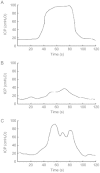The effect of platelet-rich plasma on cavernous nerve regeneration in a rat model
- PMID: 19151738
- PMCID: PMC3735030
- DOI: 10.1038/aja.2008.37
The effect of platelet-rich plasma on cavernous nerve regeneration in a rat model
Abstract
The aim of this study was to investigate the effect of platelet-rich plasma (PRP) on cavernous nerve (CN) regeneration and functional status in a nerve-crush rat model. Twenty-four Sprague-Dawley male rats were randomly divided into three equal groups: eight had a sham operation, eight underwent bilateral nerve crushing with no further intervention and eight underwent bilateral nerve crushing with an immediate application of PRP on the site of injury. Erectile function was assessed by CN electrostimulation at 3 months and nerve regeneration was assessed by toluidine blue staining of CN and nicotinamide adenine dinucleotide phosphate (NADPH)-diaphorase staining of penile tissue. Three months after surgery, in the group that underwent bilateral nerve crushing with no further intervention, the functional evaluation showed a lower mean maximal intracavernous pressure (ICP) and maximal ICP per mean arterial pressure (MAP) with CN stimulation than those in the sham group. In the group with an immediate application of PRP, the mean maximal ICP and maximal ICP/MAP were significantly higher than those in the injured control group. Histologically, the group with the application of PRP had more myelinated axons of CNs and more NADPH-diaphorase-positive nerve fibres than the injured control group but fewer than the sham group. These results show that the application of PRP to the site of CN-crush injury facilitates nerve regeneration and recovery of erectile function. Our research indicates that clinical application of PRP has potential repairing effect on CN and peripheral nerves.
Figures




Similar articles
-
Effects of intracavernous injection of adipose-derived stem cells on cavernous nerve regeneration in a rat model.Cell Mol Neurobiol. 2013 Mar;33(2):233-40. doi: 10.1007/s10571-012-9890-7. Epub 2012 Nov 17. Cell Mol Neurobiol. 2013. PMID: 23161147 Free PMC article.
-
The neuroprotective effect of platelet-rich plasma on erectile function in bilateral cavernous nerve injury rat model.J Sex Med. 2012 Nov;9(11):2838-48. doi: 10.1111/j.1743-6109.2012.02881.x. Epub 2012 Aug 20. J Sex Med. 2012. PMID: 22906160
-
Role of oxidative stress in surgical cavernous nerve injury in a rat model.J Neurosci Res. 2015 Jun;93(6):922-9. doi: 10.1002/jnr.23545. Epub 2015 Jan 19. J Neurosci Res. 2015. PMID: 25597854
-
Role of immunophilins in recovery of erectile function after cavernous nerve injury.J Sex Med. 2009 Mar;6 Suppl 3(Suppl 3):340-6. doi: 10.1111/j.1743-6109.2008.01193.x. J Sex Med. 2009. PMID: 19267858 Free PMC article. Review.
-
Three important components in the regeneration of the cavernous nerve: brain-derived neurotrophic factor, vascular endothelial growth factor and the JAK/STAT signaling pathway.Asian J Androl. 2011 Mar;13(2):231-5. doi: 10.1038/aja.2010.162. Epub 2010 Dec 20. Asian J Androl. 2011. PMID: 21170078 Free PMC article. Review.
Cited by
-
A potential treatment for erectile dysfunction: Effect of platelet-rich plasma administration on axon and collagen regeneration in cavernous nerve injury.Narra J. 2024 Aug;4(2):e880. doi: 10.52225/narra.v4i2.880. Epub 2024 Aug 5. Narra J. 2024. PMID: 39280316 Free PMC article.
-
Platelet-rich Plasma for the Treatment of Erectile Dysfunction: A Prospective, Randomized, Double-blind, Placebo-controlled Clinical Trial.J Urol. 2023 Jul;210(1):154-161. doi: 10.1097/JU.0000000000003481. Epub 2023 Apr 30. J Urol. 2023. PMID: 37120727 Free PMC article. Clinical Trial.
-
Effects of intracavernous injection of adipose-derived stem cells on cavernous nerve regeneration in a rat model.Cell Mol Neurobiol. 2013 Mar;33(2):233-40. doi: 10.1007/s10571-012-9890-7. Epub 2012 Nov 17. Cell Mol Neurobiol. 2013. PMID: 23161147 Free PMC article.
-
A review of regenerative therapies as penile rehabilitation in men following primary prostate cancer treatment: Evidence for erectile restoration and cavernous nerve regeneration.Asian J Urol. 2022 Jul;9(3):287-293. doi: 10.1016/j.ajur.2021.11.005. Epub 2021 Nov 20. Asian J Urol. 2022. PMID: 36035357 Free PMC article. Review.
-
Platelet-rich plasma intracavernosal injections for the treatment of primary organic erectile dysfunction: a systematic review and meta-analysis of contemporary controlled studies.Int J Impot Res. 2024 Sep;36(6):562-571. doi: 10.1038/s41443-023-00798-y. Epub 2023 Nov 22. Int J Impot Res. 2024. PMID: 37993601
References
-
- Walsh PC, Donker PJ. Impotence following radical prostatectomy: insight into etiology and prevention. J Urol. 1982;128:492–7. - PubMed
-
- Carrier S, Zvara P, Nunes L, Kour NW, Rehman J, et al. Regeneration of nitric oxide synthase-containing nerves after cavernous nerve neurotomy in the rat. J Urol. 1995;153:1722–7. - PubMed
-
- Lagoda G, Jin L, Lehrfeld TJ, Liu T, Burnett AL. FK506 and sildenafil promote erectile function recovery after cavernous nerve injury through antioxidative mechanisms. J Sex Med. 2007;4:908–16. - PubMed
-
- McCullough AR. Rehabilitation of erectile function following radical prostatectomy. Asian J Androl. 2008;10:61–74. - PubMed
Publication types
MeSH terms
Substances
LinkOut - more resources
Full Text Sources
Other Literature Sources
Medical
Research Materials

